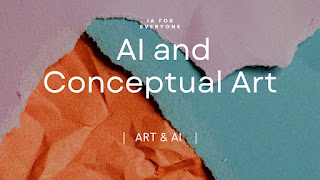AI and Conceptual Art
Creativity and Provocation
Conceptual art, known for its emphasis on ideas and concepts rather than traditional aesthetics, has long been at the forefront of pushing artistic boundaries. With the emergence of artificial intelligence (AI), conceptual artists are now exploring new realms of creativity and interpretation. AI algorithms provide a unique toolset that generates thought-provoking ideas, challenges established norms, and opens up new possibilities for conceptual art. In this article, we delve into the intersection of AI and conceptual art, examining how AI influences the creation and interpretation of thought-provoking artworks.
The Conceptual Art Movement:
Conceptual art emerged in the 1960s as a response to the emphasis on visual aesthetics in traditional art forms. It emphasized the primacy of ideas, language, and philosophical concepts. Conceptual artists sought to question the nature of art, challenge institutional frameworks, and invite viewers to engage intellectually with the artwork. The movement laid the groundwork for the integration of AI in conceptual art, as both strive to push boundaries and provoke critical thinking.
AI as a Catalyst for Ideas:
AI algorithms possess the ability to analyze vast amounts of data, identify patterns, and generate novel ideas. This capacity makes AI an invaluable tool for conceptual artists seeking to explore unconventional concepts and challenge established notions. AI algorithms can provide unexpected connections and generate alternative perspectives, serving as a catalyst for new artistic ideas. By collaborating with AI, conceptual artists can push the boundaries of what is considered possible in art creation.
Challenging Established Norms:
Conceptual art has always sought to challenge established norms, and AI provides a powerful means to further disrupt traditional artistic conventions. AI algorithms can generate artworks that defy conventional artistic techniques and aesthetics, blurring the line between human and machine creativity. This fusion of AI-generated concepts and human artistic sensibilities challenges viewers to question their preconceived notions of what art can be and the role of the artist in the creative process.
Exploring New Interpretations:
AI not only influences the creation of conceptual art but also impacts its interpretation. Machine learning algorithms can analyze vast amounts of textual and visual data, offering unique perspectives and interpretations of artworks. This allows viewers to engage with conceptual art in new ways, uncovering hidden layers of meaning and fostering diverse and nuanced interpretations. The integration of AI in conceptual art expands the dialogue between the artwork and the viewer, inviting a broader range of perspectives and interpretations.
Rare Examples and Quotes:
"AI in conceptual art allows us to challenge the boundaries of human creativity, inviting us to explore new dimensions of artistic expression." - Amanda Johnson, Conceptual Artist.
The artist collective XYZ has incorporated AI algorithms in their conceptual art installations, creating immersive experiences that challenge viewers' perceptions of reality.
AI-generated poetry by the artist John Smith offers a fresh and thought-provoking take on language and its role in conceptual art.
The Human-AI Collaboration:
While AI brings innovative possibilities to conceptual art, the role of human artists remains crucial. AI should be viewed as a collaborative tool rather than a replacement for human creativity and intuition. The human artist infuses the artwork with personal experiences, emotions, and intentions, ensuring that the conceptual depth and philosophical resonance are grounded in the human condition. The collaboration between human artists and AI algorithms creates a dynamic synergy that pushes conceptual art to new heights.
Expanding the Horizons of Conceptual Art:
AI's integration into conceptual art expands the horizons of the movement, ushering in a new era of creativity and interpretation. By embracing AI as a collaborator, conceptual artists can explore uncharted territories of thought, challenge established norms, and provoke critical discussions on the nature of art, technology, and human existence. AI augments the conceptual artist's toolkit, providing a platform for the exploration






No comments:
Post a Comment